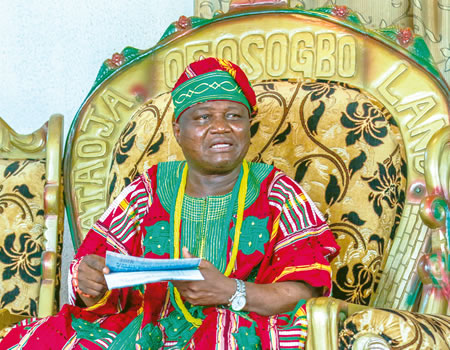A supremacy battle is threatening to unsettle the Osun State Council of Obas as the Ataoja of Osogbo, Oba Jimoh Oyetunji, and the Oluwo of Iwo, Oba Abdulrosheed Akanbi, are locked in a bitter row over who occupies the fourth position in the hierarchy of monarchs in the state.
Beyond the palaces, the tussle has spilt into the digital space, with supporters of both monarchs taking to social media to defend the honour of their rulers.
Ataoja’s loyalists argue that Osogbo’s historic role as the state capital confers a higher ranking, insisting that the stool of the Ataoja should not be relegated.
On the other hand, Oluwo’s supporters counter that the Iwo throne predates Osogbo and carries greater ancestral weight. The exchanges have often turned heated, with sharp words traded, heightening public tension.
The latest round of the dispute erupted when Ataoja, during a lecture at Osun State University to mark his 15th coronation anniversary, revisited the long-standing controversy by insisting that his stool historically occupies the fourth position in the Council—a status he alleged was wrongly ceded to the Oluwo during the reign of his predecessor, Oba Iyiola Matanmi III.
Oba Oyetunji narrated how the confusion began, stressing that he was not fighting any monarch but merely asserting the historical rights of his stool.
He said, “Late Ataoja of Osogbo, Oba Iyiola Oyewale, during his reign, went abroad, and before he came back, his position was given to the Oluwo of Iwoland. That was how Oluwo became number four in the hierarchy. That position is for Ataoja.
“When I spoke about it some time ago, people twisted my words, and that was why I kept silent. However, I have been working underground. I am not fighting any monarch, but Ataoja’s stool is number four in Osun State.”
The Ataoja also recalled an encounter with the Oba of Ila Orangun, who questioned him over his reported claim that the Oluwo ranked below him.
Oba Oyetunji explained that his remarks were misconstrued.
“When I got to Ila Orangun, he asked why I started fighting for a monarch’s position a few days after my ascension. I told him I did not know anything about that.
“He said I was quoted as saying I am the fourth monarch in ranking, while Oluwo is fifth. I explained that Oluwo and I were not fighting, but my predecessors had always occupied the fourth seat,” the monarch explained.
Despite his clarifications, Oba Oyetunji admitted that the issue continued to haunt him.
He said, “Since then, I have been silent on this issue because I do not know a way out, but I have been doing my work quietly. No matter how long you cook, the flame will go out. I am not fighting any monarch, but Ataoja’s stool is fourth in ranking in Osun State.”
Reacting to Ataoja’s fresh remarks, Oluwo fired back through his Chief Press Secretary, Alli Ibraheem, accusing Oba Oyetunji of attempting to distort history.
He urged Ataoja to seek accurate historical knowledge from respected elders of Osogbo rather than distort the hierarchy of Yoruba traditional stools.
“The good people of Iwoland are not unaware of a video circulating on social media, reportedly made by the Ataoja of Osogbo, contesting stool hierarchy.
“Personally, I watched with disappointment but no dismay. This clarification becomes necessary to protect the ancient stool of Oluwo and prevent distortion of Yoruba history.”
Oba Akanbi maintained that the Oluwo’s crown flows directly from Oduduwa, the progenitor of the Yoruba race, dismissing Ataoja’s claim of deriving his crown from Ipole as recent and politically influenced.
He said, “As far as we know, Ataoja was a Baale until 1948. Ataoja’s crown was of recent origin, along with some others, when the then military governor, David Jemibewon, decreed them into existence in 1976. Oluwo’s beaded crown is ageless and from the pristine source—undiluted and authentic.”
Oluwo also reminded Ataoja of their earlier clash at the Council, insisting that the episode was a demonstration of where true seniority lies.
The Ataoja’s secretary, Bello Oyewale, in a statement posted on social media, stressed that when Osun was carved out of old Oyo State in 1992, the Ataoja was recognised as fourth in the Council, with Oluwo following behind.
He listed other monarchs such as the Timi of Ede, the Ogiyan of Ejigbo, and the Akinrun of Ikirun as part of the vice-chairmanship cadre, maintaining that Ataoja’s stool was historically elevated as monarch of the state capital.
Sources confirmed that both monarchs clashed at a Council of Obas meeting recently when the absence of the Ooni of Ife, the Orangun of Ila, and the Owa Obokun of Ijesaland left Ataoja as the most senior monarch present.
They said Ataoja presided over the meeting until Oluwo arrived.
“Ataoja acknowledged Oluwo’s presence and continued with the meeting. Oluwo expected to be invited to preside immediately, but Oba Oyetunji didn’t do that. Oba Akanbi felt disrespected and protested.
“The meeting was disrupted, and it took the intervention of other royal fathers to restore order. The matter was later settled by the Ooni at the following month’s meeting,” they recounted.
But the Iwo Board of Trustees rejected the explanation and called on Governor Ademola Adeleke to compel Ataoja to apologise.
Its statement read, “The truth is that Ataoja’s crown was of recent origin. Oluwo’s beaded crown is ageless. No doubt, the misuse of political power is a common phenomenon in Nigeria, as it often seeks to distort authentic historical facts.
“The relative peace in Osun State must not be disturbed. We therefore call on the Governor to direct the Ataoja, with due respect, to recant the provocative statement and apologise to Oluwo and the Council of Obas.”
The Asiwaju of Osogbo, Justice Moshood Adeigbe (retd.), appealed for restraint and urged reconciliation among the monarchs.
punch.ng
FOLLOW US ON:
FACEBOOK
TWITTER
PINTEREST
TIKTOK
YOUTUBE
LINKEDIN
TUMBLR
INSTAGRAM






























